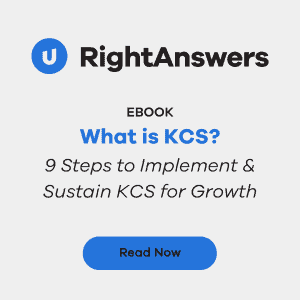By providing your customers with an easy way to find answers and resolve their own issues, you will reduce the number of calls your service organization receives while providing a better experience for your customers – a win all around. But how can you steer your customers to your self-service portal? Here are some tips to increase self-service adoption:
1. Understand the current customer journey
Most of us like to think we completely understand our own processes, and maybe we do, but taking time to really ensure you know the norm for customers contacting you via your current channels of support will help you greatly when it comes to leading them into the world of self service.
Don’t just look at the data! Be the customer, take the journey from discovering the issue, to finding the customer services contact details, making contact, answering questions, working through the issue/question, maybe having a ticket passed to another team or having the call transferred, awaiting further contact, all the way through to resolution.
This is a great exercise to ensure you are giving great service via your other channels, as well as understanding where there are opportunities for your self-service offering to surpass these.
KEY TAKEAWAY: Don’t just look at the data, really seek to understand the current customer journey.
2. Don’t hide your light under a bushel
The first step to getting your customers to use your self-service portal is making sure they know about it.
Some ways to get the word out: your IVR and hold messages, and service agents promoting self-service during conversations with customers.
If your customers will be accessing the self-service from within an existing website, make sure it is easy to find and clear to your customers why it is there.
KEY TAKEAWAY: Customers won’t use it unless they know about it!
3. Make self-service the path of least resistance
When seeking out help, customers will most often follow the path of least resistance. If they need to contact you, they want to do so in the quickest and easiest manner. Making self-service the path of least resistance is key.
You can only do this if you have carefully studied your current customer journey (see point 1, above) and sought out opportunities for self-service to surpass this. For example: Fewer clicks to get into self-service than to find the customer service phone number.
KEY TAKEAWAY: Make self-service the easiest channel to use for the people you’re targeting for self-service.
4. Offer incentives and build loyalty
Short- and long-term incentives should be considered when you are looking to draw your customers to self-service.
Short-term incentives (such as offering a Kindle as a prize draw for those who used self-service in the first month) will help greatly with initial adoption, but they are unlikely to create ongoing loyalty to the site.
Easy is the new loyalty. Longer-term loyalty comes from making the self-service avenue the path of least resistance for your customers. Make it preferred over picking up the phone because it is easier.
KEY TAKEAWAY: Incentives bring initial awareness; ease brings long-term loyalty.
5. Create an identity
Create a strong brand for your self-service to help people remember and identify with the service.
For example: “The source” is a name people are likely to remember, i.e., something short that indicates a place to find knowledge. Brand placement and repetition is also important within the site.
KEY TAKEAWAY: Create a strong brand name and a recognizable logo.
6. Speak their language
In your self-service portal, use language that your customers can identify with, including titles and headers. Gear the language to the needs of your audience. A very complex-sounding site will likely scare people away. For example, say “Tell us about your issue” rather than “Raise a ticket.”
KEY TAKEAWAY: Use language that is clear to your audience.
7. Keep it fresh
Make sure content is kept up to date. If people feel the information is not being reviewed and refreshed, they will lose trust in it and will likely not return. Refreshing announcements each week is recommended. Employ a methodology such as Knowledge-Centered Support (KCS) that puts guidelines in place for creating and maintaining knowledge.
KEY TAKEAWAY: Keep the knowledge base current.
8. Consider the look & feel
Don’t overwhelm people with information. Focus on the high-frequency demand first rather than pushing lots of information out there ‘just in case.’ Make sure the portal looks fresh and inviting.
KEY TAKEAWAY: Less is more.
9. Gather feedback
Ask for input from those who will/do use the service. Assumptions about your customers can lead to mistakes in designing your user experience.
Seek feedback from detractors as well as promoters; they often have valuable ideas and are very willing to share. Look at what you can do to reduce the complaints and turn them into compliments. This often involves just getting rid of procedures that make it difficult for customers.
KEY TAKEAWAY: Seek feedback from a broad range of people, including detractors.
10. Think about what you’re measuring
Measure outcomes (such as a reduction in call volume), not activities (such as the number of articles each agent creates). Based on your organizational goals, choose suitable measures around these outcomes. Measuring the wrong thing will drive the wrong behavior and will ultimately detract from your success.
Forced feedback should be used sparingly – constantly seeking feedback via additional clicks can become frustrating to customers. Use it when you will do something with the results, not just for the sake of collecting metrics.
KEY TAKEAWAY: Measure high-value outcomes, not activities.
11. Edicts
An edict “an official order given by a person in authority” and in the self-service world it can be a very powerful thing. Edicts help push customers down the paths you want them to take. These are especially effective when the reasoning behind them is shared with the customer.
An example of an edict: We will only provide help and support for your online account if you have set up your security questions and provided us with your latest contact details.
KEY TAKEAWAY: Explain the reasons behind any edicts. People are far more receptive to edicts if the benefits are articulated.
12. Teach your agents how to say ‘No’
A soft ‘no’ can be used very effectively with your agents. It enables them to steer customers down the right path, without seeming like they are forcing them.
Example: “I will give you this information, but it’s quicker for you if I show you how you can find this yourself within the self-service portal. That way you can access this information any time you want, without needing to contact us. Let me show you how…”
KEY TAKEAWAY: Use positive language to steer your customers, without saying ‘no.’
Author: Tom Policano



